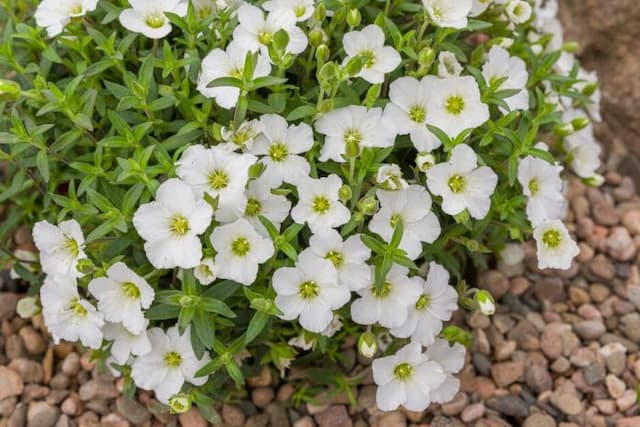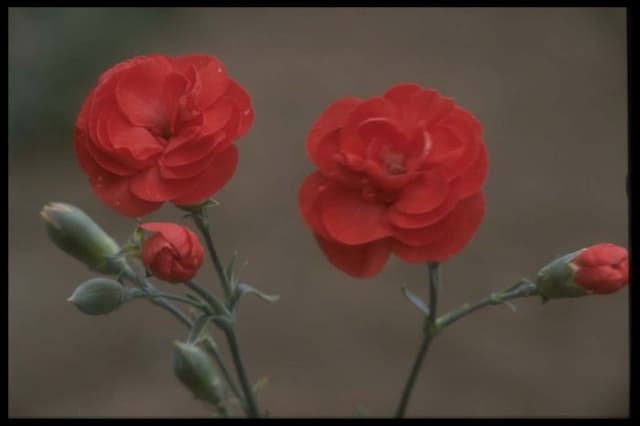Baby's Breath Gypsophila paniculata Summer Sparkles = 'Esm Chispa' (PBR)

ABOUT
The plant commonly known as Baby's Breath 'Summer Sparkles', is best known for its delicate and airy appearance. It features an abundance of tiny, pure white flowers that cluster together to form cloud-like blooms, which seem to float above the foliage. The leaves of Baby's Breath 'Summer Sparkles' are narrow and light green, providing a gentle backdrop that highlights the frothy flowers. This plant creates a soft, romantic effect wherever it is planted, and is especially popular in floral arrangements and as a filler in garden beds, where its blossoms can create a sense of fullness and texture. The overall impression of Baby's Breath 'Summer Sparkles' is one of lightness and grace, making it a charming addition to any garden space.
About this plant
 Names
NamesFamily
Caryophyllaceae
Synonyms
Baby's Breath, Gyp, Bristol Fairy, Showers of Snow
Common names
Gypsophila paniculata Summer Sparkles.
 Toxicity
ToxicityTo humans
Baby's breath is generally considered non-toxic to humans. However, like many plants, it can cause mild gastrointestinal discomfort if ingested in large quantities. It is not associated with severe poisoning or life-threatening effects.
To pets
Baby's breath is typically safe for pets, including dogs and cats. It is not listed among the plants that are commonly known to be toxic to pets. However, ingestion of any plant material may cause mild digestive upset such as vomiting or diarrhea in some animals, especially if consumed in large amounts.
 Characteristics
CharacteristicsLife cycle
Perennials
Foliage type
Deciduous
Color of leaves
Green
Flower color
White
Height
2-3 feet (60-90 cm)
Spread
2-3 feet (60-90 cm)
Plant type
Herb
Hardiness zones
3-9
Native area
Eurasia
Benefits
 General Benefits
General Benefits- Attracts Pollinators: Gypsophila paniculata Summer Sparkles is known for attracting bees, butterflies, and other beneficial insects to the garden.
- Easy to Grow: This plant is considered easy to cultivate, requiring minimal maintenance, which makes it ideal for both novice and experienced gardeners.
- Drought Tolerant: Once established, Gypsophila paniculata is drought-resistant, making it suitable for xeriscaping and for gardens in drier climates.
- Long Blooming Season: It offers a long flowering season, providing delicate white blooms throughout the summer months.
- Ornamental Appeal: The airy, cloud-like appearance of its flowers adds a light, whimsical touch to garden beds and borders.
- Cut Flower Use: The stems of Gypsophila paniculata are popular in floral arrangements, both fresh and dried, due to their longevity and beautiful blooms.
- Suitable for Containers: This versatile plant can also be grown in pots or containers, making it suitable for balconies and patios.
- Landscape Design: Its fine texture contrasts well with larger-leaved plants, making it a valuable addition to landscape design for texture variety.
- Cottage Garden Style: The plant fits well into cottage garden themes, adding an element of rustic charm.
 Medical Properties
Medical PropertiesThis plant is not used for medical purposes.
 Air-purifying Qualities
Air-purifying QualitiesThis plant is not specifically known for air purifying qualities.
 Other Uses
Other Uses- Floral Dyes: The flowers of Baby's Breath can be used to create natural dyes for textiles, delivering soft hues when processed correctly.
- Photography Props: Dried Baby's Breath is often used in photoshoots to add a whimsical or rustic aesthetic to portraits, still lifes, and wedding photography.
- Homemade Potpourri: Dried Baby's Breath can be mixed with other dried flowers and spices to create aromatic potpourri for freshening up homes.
- Art Supplies: Pressed Baby's Breath flowers can be used in mixed media art projects, including resin jewelry, bookmarks, and greeting cards.
- Decoration for Cakes: Fresh or crystallized Baby's Breath can be used as an edible decoration for cakes and desserts, imparting a delicate touch to the presentation.
- Bookmarks: By laminating Baby's Breath, individuals can create beautiful and natural bookmarks that make for lovely gifts or keepsakes.
- Candle Embeds: Baby's Breath can be embedded in homemade candles to add a natural and decorative element that is revealed as the candle burns down.
- Paper Making: When making handmade paper, small bits of Baby's Breath can be incorporated into the pulp to create a unique texture and design in the final product.
- Floral Ice Cubes: Baby's Breath can be frozen in ice cubes to create an elegant touch for punch bowls or cocktails at special events.
- Bath Bombs: Dried Baby's Breath can be included in homemade bath bombs for a touch of natural decor; they float on top of the bathwater when the bomb dissolves.
Interesting Facts
 Feng Shui
Feng ShuiBaby's breath is not used in Feng Shui practice.
 Zodiac Sign Compitability
Zodiac Sign CompitabilityBaby's breath is not used in astrology practice.
 Plant Symbolism
Plant Symbolism- Purity: Baby's Breath, the common name for Gypsophila paniculata, often symbolizes purity due to its delicate white flowers, frequently used in bridal bouquets and christening ceremonies.
- Innocence: The soft and airy appearance of Baby's Breath is commonly associated with innocence, echoing the simplicity and untouched nature of the plant.
- Love: Baby's Breath is a renowned symbol of everlasting love and affection, often used in wedding decor to represent the enduring bond between couples.
- Compassion: Sometimes, the plant is used to express empathy and kindness, making it appropriate for occasions that involve offering support and understanding.
- Freedom: Because of its ability to sprawl and expand freely, Baby's Breath can also symbolize freedom, signifying liberation and the boundless nature of the human spirit.
 Water
WaterWater your Baby's Breath 'Summer Sparkles' deeply and allow the soil to dry out somewhat between waterings. During the growing season, water it approximately once a week, providing about 1 gallon of water for each plant, adjusting for rainfall. Reduce watering in the winter when the plant is dormant. Over-watering can lead to root rot, so ensure the plant has well-draining soil and is not left in waterlogged conditions.
 Light
LightBaby's Breath 'Summer Sparkles' thrives best in full sun exposure. Place the plant where it can receive at least 6 hours of direct sunlight daily. Avoid locations with prolonged shade to ensure the plant has sufficient light for optimal growth and flower production.
 Temperature
TemperatureBaby's Breath 'Summer Sparkles' can tolerate a range of temperature conditions but prefers a cooler climate with temperatures ideally between 60°F and 75°F. It can survive minimum temperatures down to around 20°F. Avoid exposing it to prolonged periods of high heat above 85°F.
 Pruning
PruningPruning Baby's Breath 'Summer Sparkles' encourages bushier growth and can enhance flowering. Prune in the early spring by cutting back the previous year's growth to about 4 inches from the ground. Prune again lightly after the first flush of blooms to promote a second flowering period. Pruning is best done when the plant is dormant.
 Cleaning
CleaningAs needed
 Soil
SoilBaby's breath (Gypsophila paniculata) thrives in well-draining soil with a mix of loam, sand, and compost. A soil pH between 6.5 and 7.5 is optimal for its growth and flowering.
 Repotting
RepottingBaby's breath typically doesn't need frequent repotting. It may be repotted once every 2-3 years or when it outgrows its current container, whichever comes first.
 Humidity & Misting
Humidity & MistingBaby's breath prefers moderate humidity levels. Aim to maintain indoor relative humidity between 40% and 60%, which is comfortable for most homes and adequate for this plant.
 Suitable locations
Suitable locationsIndoor
Provide full sun and well-draining soil for healthy growth.
Outdoor
Plant in full sun, well-drained soil; water regularly.
Hardiness zone
3-9 USDA
 Life cycle
Life cycleGypsophila paniculata Summer Sparkles begins its life cycle through seed germination, where the seed requires a well-draining soil medium and light for optimal growth. After germination, the seedling grows into a vegetative state, developing a strong root system and foliage in response to adequate sunlight and nutrients. The plant then enters the flowering stage, typically in the summer months, producing numerous small, white flowers that contribute to its ornamental appeal. Post-flowering, it sets seeds which, if not deadheaded, can spread to create new plants the following season. As a perennial, G. paniculata dies back to its crown during winter dormancy, conserving energy to regrow in spring. The lifecycle can repeat for several years, with proper care, before the plant may require division or replacement.
 Propogation
PropogationPropogation time
Spring-Summer
The most popular method for propagating Baby's Breath (Gypsophila paniculata Summer Sparkles = 'Esm Chispa' (PBR)) is through cuttings. The ideal time to take cuttings is in late spring to early summer when the plant is actively growing. Select healthy, non-flowering stems about 4 to 6 inches long. Strip the leaves from the lower half of the cutting, and dip the cut end in rooting hormone to encourage root development. The cutting should then be placed in a well-draining soil mix, ensuring that the leafless part is buried. Keep the soil moist but not waterlogged, and place the pot in a warm location with indirect light. Roots typically develop in a few weeks, after which the new plants can be gradually acclimatized to outdoor conditions before transplanting.


![Pink [Tequila Sunrise]](/_next/image?url=https%3A%2F%2Fplants-admin.emdemapps.com%2Fimages%2Fplants%2F%2Fimages%2F604b5d995d06e.png&w=640&q=75)






